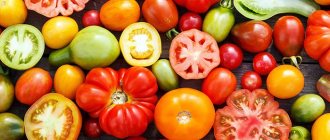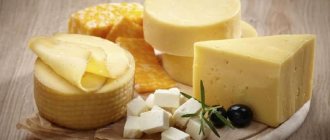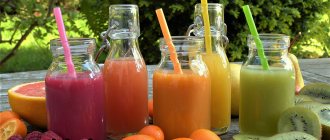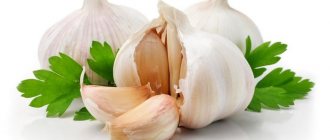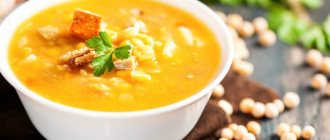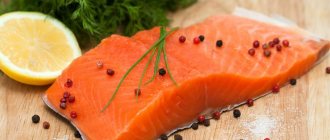Mushrooms are a rather ambiguous product: allergenic, but at the same time rich in many useful substances, difficult to digest, but very nutritious. At the same time, false or poisonous varieties can lead to severe poisoning of an absolutely healthy person. How to treat mushrooms while breastfeeding? After all, there are a lot of varieties of them; surely some varieties or mushroom dishes can be eaten by nursing mothers.
Mushrooms are a rather controversial product in the diet of a nursing mother. They should be prepared and eaten with special care and attention.
Beneficial features
In terms of protein content and energy value, this product can only be compared with meat. Therefore, mushrooms are often included in the diet menu - a product with a minimum kcal content saturates the body quite quickly and for a long time. Of the beneficial substances, these gifts of the forest contain: amino acids, vitamins E, B, A, iron, phosphorus, zinc, beta-carotene, melanin and chitin. Thanks to the latter, harmful toxins are removed from the body. The rich composition of mushrooms brings the following benefits to the body:
- strengthening the immune system and muscles;
- strengthening the nail plate, tooth enamel, improving the skin;
- quick feeling of fullness;
- replenishment of energy reserves, restoration of strength, vigor;
- fight against insomnia;
- improved vision;
- restoration and maintenance of nerve cells;
- cleansing the body of harmful cholesterol, cleansing the blood;
- fight against tuberculosis (chanterelles only);
- suppression of the inflammatory process;
- protecting the body from colds and infectious diseases;
- reducing the risk of cancer and cardiovascular diseases.
Mushrooms when breastfeeding a newborn
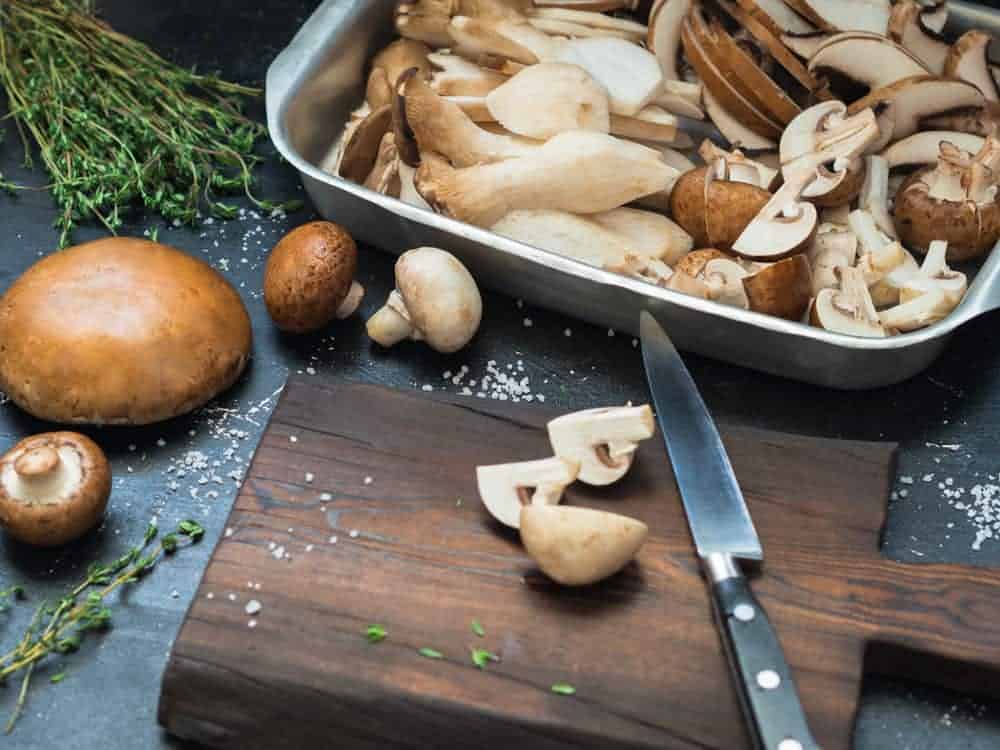
The lactation period means the need to properly formulate the diet in order to provide maximum benefit to the child and not harm him. You can eat mushrooms while breastfeeding, but not all of them and with restrictions. Mushrooms are nutritious and healthy, but when breastfeeding they are consumed with restrictions.
- Composition and benefits of mushrooms
- Harm and contraindications
- Tea mushroom
- What mushrooms can you eat while breastfeeding?
- When can you diversify your diet?
- How to choose the right mushrooms
- What mushroom dishes are possible while breastfeeding?
Composition and benefits of mushrooms
These products are nutritious and tasty. Its chemical composition is presented:
- vitamins A, D, F, group B;
- ascorbic acid;
- magnesium;
- sodium;
- iron;
- potassium;
- phosphorus.
The product contains many amino acids. It combines proteins of both plant and animal origin.
A significant advantage is the complete absence of cholesterol.
The composition also includes lecithin, glycerides of fatty acids, unsaturated fatty acids - butyric, stearic, palmitic.
Features of the composition depend on the type of raw material. The calorie content of porcini mushrooms is 34 kcal.
They contain 3.7% protein, 1.1% carbohydrates, 3.2% dietary fiber and 89.4% water. In 100 g honey mushrooms there are 22 kcal, 2.2% proteins, 0.5% carbohydrates, 5.1% dietary fiber and 90% water.
Mushroom dishes are comparable in nutritional value to meat and are not inferior to vegetables and fruits.
This quality is not lost even after heat treatment. Such properties are valuable for vegetarians and people who cannot eat meat.
Mushroom dishes are not only tasty, but also healthy. This is due to the following properties of the product:
• Strengthening the immune system.
• Prevention of asthenia.
• Giving the body additional energy.
• Prevention of oncology and pathologies of the cardiovascular system.
• Due to its melanin content, the product is a strong antioxidant.
• The absence of cholesterol, high water content, rich vitamin and mineral composition allow us to rightfully consider the product dietary.
• Promoting the removal of cholesterol from the body.
• Positive effect on the functioning of nerve cells.
• Fight against inflammatory processes.
Harm and contraindications
The most negative side of mushrooms is the possibility of poisoning. To avoid it, you should carefully select raw materials, as there are many inedible varieties.
It is also important to store the product correctly and prepare it correctly.
Just one mushroom can cause acute poisoning!
You can also be poisoned by edible species if they are collected within the city, an industrial zone, or near a highway.
In this case, the atmosphere contains an increased volume of toxic compounds that are absorbed by the fungi.
Even heat treatment does not always eliminate harmful substances.
Useful tips for mothers: NUTRITION FOR A NURSING MOTHER
Due to the high content of chitin, mushroom dishes take a long time to digest and can cause heaviness.
Another drawback is a decrease in the production of gastric juice. If you have problems with the gastrointestinal tract, it is better to avoid such food.
Contraindications also include impaired functioning of the kidneys and liver.
Another possible problem is botulism. This severe toxic infectious disease affects the nervous system.
More often, this disease is observed when consuming home-canned food, when the manufacturing technology has been violated.
Tea mushroom
Kombucha is called differently - Manchurian or Japanese, Japanese uterus, sea kvass, tea jellyfish, medusomycete, fango. In composition, it consists of yeast and acetic acid bacteria.
Medusomycete is used to make a slightly carbonated refreshing drink.
It not only perfectly quenches thirst, but also has healing properties:
- antibacterial;
- antimicrobial;
- antiparasitic;
- calming;
- antihypertensive;
- cleansing of impurities and toxins.
Sea kvass is good for the cardiovascular system, accelerates metabolism, promotes weight loss, and normalizes the functioning of the gastrointestinal tract.
Its composition is represented by organic acids, enzymes, lipids, mono- and disaccharides, vitamins D, PP, group B, ascorbic acid, chlorophyll.
Due to the acetic acid content, the drink should be consumed in small quantities. You can neutralize the harm of the acid by adding honey if the child is not allergic to this product.
Nursing mothers can drink this healing solution, but dilute it in four parts of water. For the first time, it is enough to drink a quarter glass of the drink to check the child’s reaction.
In the future, you can drink half a glass twice a day. You can only consume freshly prepared infusion, which is no more than 3-4 days old.
What mushrooms can you eat while breastfeeding?
Champignons and oyster mushrooms are considered the safest option for a nursing mother.
The first variety can be white, brown, dark. The safety of such products is explained by their artificial cultivation under environmental conditions.
If a nursing mother does not want to give up wild mushrooms, then she should limit herself to chanterelles. The use of boletus and boletus is allowed.
Dr. Komarovsky is against the inclusion of forest mushrooms in the diet of a nursing mother.
This belief is associated with a high risk of poisoning due to the possible consumption of an inedible variety or high accumulation of toxins.
When can you diversify your diet?
In the first month, such products cannot be consumed in any form. The child’s digestive tract is not yet ready for this.
You can try a mushroom dish no earlier than 5-6 months. For the first time, one teaspoon is enough.
The baby's reaction should be observed for two days.
If there were no negative consequences, then sometimes you can treat yourself to mushrooms. You can eat no more than 50-60 grams of the product per day.
If the baby reacts poorly to such a new addition to the diet, then it is better to give up mushroom dishes until the end of breastfeeding. At the slightest sign of poisoning, you should immediately consult a doctor.
Many experts recommend waiting until 10-12 months to introduce wild mushrooms into the diet.
Due to prolonged digestion, it is better not to experiment until the end of the lactation period - such food is not recommended for children under school age.
How to choose the right mushrooms
If you collect raw materials yourself, you need to be sure that they are edible. Conditionally edible varieties are best ignored.
You should only buy champignons or oyster mushrooms in the store. The packaging must indicate the manufacturer, the date of packaging of the raw materials and its expiration date.
They do not purchase products on the market. Poisonous specimens may be found in it, and the place where the raw materials are collected is unknown - it can also be collected for sale along the roads.
What mushroom dishes are possible while breastfeeding?
During breastfeeding, such products must be subjected to heat treatment.
It is better to limit yourself to boiling or stewing. If you stew a mushroom dish, you can additionally use onions or sour cream.
Champignons can be used to make puree soup. Large specimens are best stuffed with various fillings and baked in the oven.
Oyster mushrooms are best used for stewing. The finished dish is consumed on its own or added to salads.
Cutlets or zrazy are stuffed with champignons and added to potatoes, cereals, and vegetable side dishes.
For cooking you need to use only fresh raw materials. Dried and frozen products should be discarded.
Pickled and salted mushrooms are contraindicated for nursing mothers. To prepare them, use vinegar, plenty of salt, and spices.
This negatively affects lactation and the functioning of the gastrointestinal tract. Purchased products may contain preservatives, flavor enhancers and flavorings.
It is better to opt for oyster mushrooms and champignons. You can eat them in small quantities, and when preparing them, limit them to boiling and stewing.
- about the author
- Recent publications
Svetlana Ovechkina
author of the publication (site editor)
TEACHER Higher pedagogical education. Director of the kindergarten.
Svetlana Ovechkina recently published (see all)
- Turkey as a first complementary food - 01/14/2021
- 7 month old baby’s daily routine – 03/28/2019
- Chocolate during breastfeeding - 03/25/2019
Possible harm
First of all, no one is safe from consuming a poisonous product. Sometimes false specimens can be very difficult to distinguish externally from real ones, but poisoning with inedible mushrooms can lead to extremely serious consequences and even death. In addition, it is important to know in which area the mushrooms were collected, since they absorb the entire composition of the soil in which they grow. And if the area is contaminated, then the mushrooms will accumulate toxins and heavy metals, which, if passed on to the baby through breast milk, will cause significant harm to the baby’s health.
If a nursing mother is susceptible to allergic reactions to many foods, in particular mushrooms, then most likely, if they are consumed, the child will also develop an allergy. A negative reaction can manifest itself in the form of redness, a rash on the body, peeling of the skin, less often watery eyes, coughing, and breathing problems.
Even cultivated mushrooms can affect the digestive system.
Such a product on the menu of a nursing woman can cause colic, bloating, and intestinal disorders in a newborn.
The disadvantage of the product is also the excessive load on the kidneys, since the product helps eliminate excess fluid. Therefore, if a woman has problems with the functioning of the urinary system, then it is worth holding off on eating mushrooms. Mothers who suffer from diseases of the digestive system and colitis will have to give up this ingredient. Indeed, due to their saturation with protein, mushrooms are a product too difficult to digest.
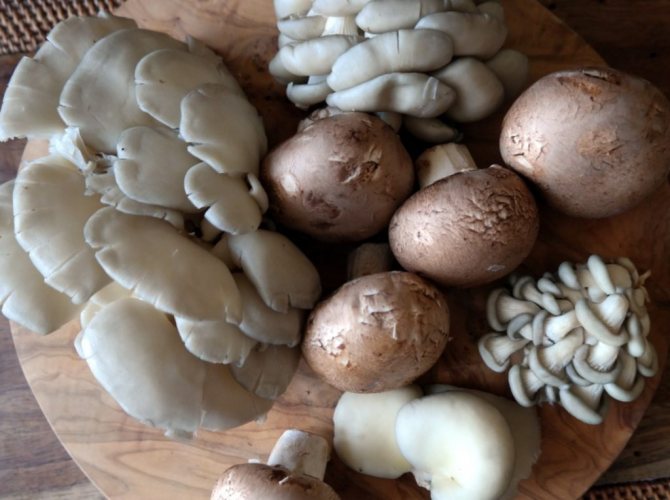
Cultivated mushrooms, such as champignons and oyster mushrooms, are allowed for consumption during lactation.
Harm of pickled mushrooms for a nursing mother and baby
The main harm of salted mushrooms is the high toxicity of the product. During the growth process, mushrooms absorb from the soil not only useful substances, but also toxins and heavy metal salts, which can cause serious intoxication of the body.
- Eating salted mushrooms puts an increased burden on the liver, kidneys, and gall bladder.
- The high content of salt, acetic acid and spices in their composition can lead to heartburn, increased stomach acidity, stool disorders, and also negatively affect the quantity and quality of breast milk.
Mushrooms are a highly allergenic product. Among infants, there are often side effects from the mother's consumption of dishes with mushrooms.
These include:
- redness on the skin, allergic rash;
- flatulence, increased colic;
- nausea, belching and even vomiting;
- excessive anxiety in the baby, sleep disturbances;
- other individual reactions.
In addition, if chosen or prepared incorrectly, mushrooms can cause severe food poisoning.
What mushrooms can you
Wild mushrooms pose a great danger to women during lactation, and artificially grown oyster mushrooms or champignons can be eaten while breastfeeding. From natural varieties you can prepare white, boletus or chanterelle, which, among other advantages, also have an antibiotic function, and also help improve sleep, fight fatigue, improve vision, and keep muscles toned. If you want to clarify how to cook mushrooms during breastfeeding, then it is best to eat soup with the addition of this product (see recipe below), while the use of dried mushrooms is allowed. In modern cooking, all available methods of preparing mushrooms are used - they are fried, boiled, baked and stewed. But when fried, they will bring extra calories to a nursing woman; moreover, when cooked at high enough temperatures, mushrooms lose most of their beneficial properties.
Is it possible for a nursing mother
Is it possible to have porcini mushrooms while breastfeeding , as well as boletuses, oyster mushrooms, chanterelles and other varieties? According to Komarovsky and other pediatricians, mothers of newborn children should not eat such food. It is added to the diet only after the child is 6-12 months old.
When used correctly, the product benefits the body:
- increases immune defense, reduces morbidity during periods of epidemics;
- eliminates inflammatory processes;
- improves the process of hematopoiesis, removes cholesterol and toxins from the body;
- reduces the risk of developing cancer and cardiovascular diseases;
- strengthens muscle tissue;
- improves the condition of nails, teeth, skin;
- energizes, restores strength;
- relieves insomnia;
- improves vision.
What mushrooms are not allowed?
During lactation, you should not eat salted, pickled or canned mushrooms. If they are purchased, then it is not known where they were grown and what additives were used in production. Also, when making preparations, salt, pepper, and spices are used in large quantities, which are not recommended for use during breastfeeding. Such preservatives can affect the taste of breast milk. If a young mother still cannot resist eating a delicious dish, then eating mushrooms is allowed no earlier than after two months of the baby’s life.
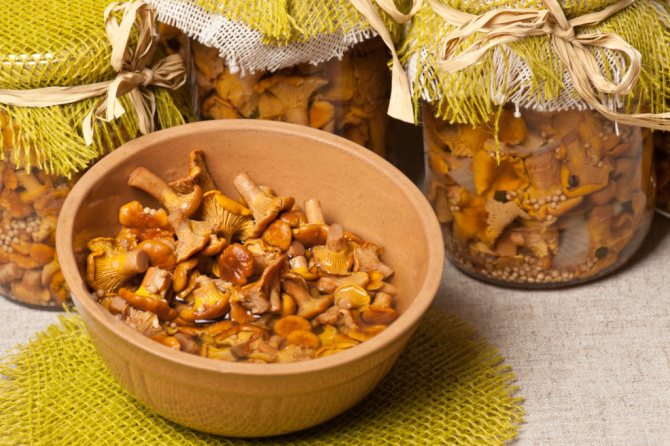
It is recommended to exclude canned mushrooms from the diet in the first months of breastfeeding.
What are the benefits of salted mushrooms during breastfeeding?
Mushrooms are a healthy product containing a large amount of vitamins, minerals, healthy carbohydrates and vegetable protein. Regular consumption of salted mushrooms can replenish the supply of essential substances in the human body no worse than consumption of vegetables, fruits, and meat dishes. In addition, they have a pleasant taste and are suitable for many different dishes.
Salted mushrooms are best eaten with potatoes or boiled vegetables.
Salted mushrooms go well with onions and olive or vegetable oil. It is preferable to eat such mushrooms in the first half of the day so as not to burden the stomach before bed. After all, such a dish takes a long time to digest.
The main positive functions of salted mushrooms are:
- Salted mushrooms are digested slowly, resulting in a long-lasting and lasting feeling of fullness.
- Most of the mushroom consists of water, which makes them useful for maintaining hydration in the body.
- Salted mushrooms are recommended for people with gastrointestinal diseases. The liquid released when pickling mushrooms plays the role of a kind of barrier between the walls of the stomach and gastric juice.
- Mushrooms in this form contribute to the proper functioning of the nervous and circulatory systems.
- Due to the increased zinc content, they reduce the body's need for sweets and sugar and normalize the functioning of the pancreas.
- Regular use of this product has a positive effect on the appearance of a young mother. Nails, teeth and hair are strengthened, skin condition improves.
- In some traditional medicine recipes they are used as a prevention and treatment of inflammatory, viral and colds.
How to include the product in your diet
Even during normal periods of life, mushrooms are carefully sorted, cooked for a long time, and their preparation is taken very seriously. And during breastfeeding, careful adherence to certain rules for introducing the product into the diet is especially required:
- You can buy healthy delicacies only in trusted stores or specialized markets; you should not buy mushrooms from grandmothers.
- It is better to leave forest varieties until the end of feeding, but during breastfeeding there are cultivated oyster mushrooms or champignons.
- Dried mushrooms are more concentrated, so a serving of 40 grams will be enough for mom to eat, and when cooked, no more than 200 grams.
- You should not eat pickled honey mushrooms or salted milk mushrooms; such food will not bring any benefit, but on the contrary, will reduce the quality of mother’s milk.
Rules and regulations for use
When eating mushrooms, you need to follow several rules:
- The product is introduced into your diet when the baby is at least 6 months old. At this age, the functioning of the digestive tract stabilizes, colic and problems with stool disappear. Six months after giving birth, you can only eat “cultivated” mushrooms that are grown in production. It is better to postpone the consumption of forest varieties until the child is 10-12 months old.
- For the first time, eat no more than 4-5 pieces. After this, carefully monitor the baby and note any changes in his well-being. Allergy and stomach symptoms occur within a few hours of breastfeeding. But signs of poisoning may appear only on the second day. If any suspicious symptoms develop, you should contact your doctor.
- Until the child is one year old, mushrooms are eaten twice a month. Then - 1 time per week. You are allowed to consume no more than 60 g of the product per day.
Recipes for mushroom dishes for gw
Mushroom soup
A serving of this soup will bring a nursing mother a significant amount of vegetable proteins, which are important not only for the female body, but also for the further development of the baby.
Ingredients: potatoes, champignons, butter, carrots, turnips, sour cream, herbs for dressing.
Add 5 pieces to boiling water. potatoes and 1 medium turnip, diced, 2 grated carrots, boil until tender. Fry 250 g of fresh champignons in butter and add to the potatoes. When serving, add sour cream and herbs to the finished soup.
Mushroom cutlets with buckwheat
To diversify the menu of a nursing mother, you can prepare cutlets with the addition of mushrooms.
Ingredients: oyster mushrooms or champignons, buckwheat, flour, carrots, onions.
Boil half a glass of buckwheat. Finely chop 100 g of oyster mushrooms and 1 onion, grate 1 carrot. Fry onions, carrots, add mushrooms and buckwheat, add 2 tablespoons of flour, add a little vegetable oil. Form cutlets and cook in your favorite way - fry, bake in the oven or steam.

Mushroom cutlets with buckwheat, or grechaniki, are an excellent dish to diversify the diet of a nursing mother.
Rice with champignons
Mushrooms, containing a large amount of vitamins, are quite nutritious, so they can easily replace meat in the diet of a nursing woman. You can serve rice as a side dish.
Ingredients: champignons, rice, carrots, onions, greens.
Peel 1 onion and 1 carrot, finely chop and simmer in vegetable oil. Add 350 g of champignons, simmer for 10 minutes. Add salt, pour 200 g of rice and twice as much water into the same bowl. Let the dish boil, then cover with a lid and simmer until the rice is cooked.
Possible baby reaction
Mushrooms contain substances that are difficult for the child’s body to digest, so the child may experience colic and intestinal disorders. Allergic reactions and liver dysfunction are also possible.
Eating poisonous varieties and mushrooms growing in contaminated areas can lead to poisoning. In this case, the child will have symptoms such as vomiting, diarrhea, fever, pale skin, etc.
If you suspect intoxication, you should immediately seek emergency medical help.



